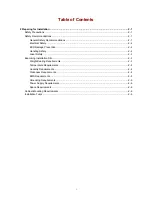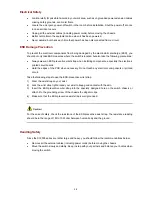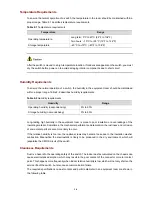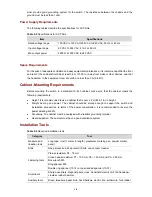
2-4
Temperature Requirements
To ensure the normal operation of a switch, the temperature in the room should be maintained within a
proper range. Table 2-1 describes temperature requirements.
Table 2-1
Temperature requirements
Temperature
Range
Operating temperature
Long term: 0°C to 40°C (32°F to 104°F)
Two hours: –10°C to +50°C (14°F to 122°F)
Storage temperature
–40°C to +70°C (–40°F to 158°F)
After the switch is moved to a high-temperature location, if condensate appears on the switch, you must
dry the switch before power-on to avoid damaging interior components due to short circuit.
Humidity Requirements
To ensure the normal operation of a switch, the humidity in the equipment room should be maintained
within a proper range. Table 2-2 describes humidity requirements.
Table 2-2
Humidity requirements
Humidity
Range
Operating humidity (noncondensing)
5% to 90%
Storage humidity (noncondensing)
5% to 95%
Long-lasting high humidity in the equipment room is prone to poor insulation or even leakage of the
insulating material. Sometimes, the mechanical performance deterioration, the rustiness and corrosion
of some metal parts are also more likely to occur.
If the relative humidity is too low, the captive screws may become loose due to the insulation washer
contraction. Meanwhile, the electrostatic is likely to be produced in the dry environment, which will
jeopardize the CMOS circuit of the switch.
Cleanness Requirements
Dust is a hazard to the operating safety of the switch. The indoor dust accumulated on the chassis can
cause electrostatic adsorption, which may result in the poor contact of the connector or metal contact
point. This happens more frequently when indoor relative humidity is low, which will not only shorten the
service life of the switch, but also cause communication failure.
The required specifications on dust content and particle diameter in an equipment room are shown in
the following table.
















































